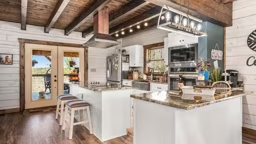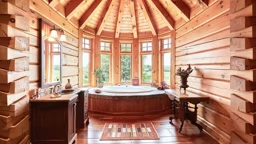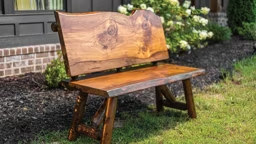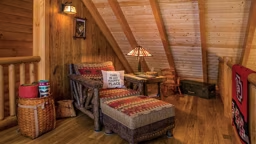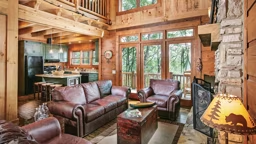
This modern mountain log home's interior design features an expansive folding wall that opens the interior
completely to the exterior patio.
By the time many of you start thinking about your log home's interior spaces, the initial glow that came with the idea of building your log home will have faded into a sea of missed deadlines and costly change orders.
For this and many other reasons, the best approach to decorating your log home is to plan its interiors during the initial design stage. At that point in the project, you're more likely to enjoy the process and will probably be more satisfied with the outcome. Unfortunately, we have to be realistic, and that means most of us don't have the resources to do it that way.
Time is at a premium throughout the entire design-build process. Cash may be just as short, and your mind is so occupied with hundreds of other choices — dark or light stain on those logs? — it won't want to be bothered with fabric and paint swatches.
If you approach it right, however, you should be able to squeeze enough time out of your day — and cash out of your budget — to plan your interior design scheme before or during construction. It will be hard work; it will require organization and quick decisions. But you can prepare by thinking ahead about the following decorating issues and, hopefully, establish the ground rules for your home's interior design scheme.
Define, Then Budget
In decorating, starting at the beginning means defining the scope of the project.
Whether building a new log home or refurbishing an existing one, you have two options. You can approach decorating room by room or treat the house as a whole. Most experts agree the best strategy is to find a comfortable plan of attack between the two.
Because your interior spaces should complement each other, you should consider the whole house as you choose basic elements like color schemes and styles. This will ensure your home has a consistent flow and feel throughout. Once you've selected a color palette and style, you can use them as guidelines for choosing the elements that will create each room's identity and personality.
Unless you want to stop eating while you remodel the kitchen, you'll have to take the one-room-at-a-time approach if you already live in your log home. That doesn't mean, however, that you can't define each potential project within the broader scope of a whole-house facelift, then complete the projects one at a time.
Of course, all this planning means nothing if you can't afford it. Before you sit down to define your decorating project, create a budget. Be realistic; figure in a contingency for overruns and unexpected expenses.
If you don't know how much to budget for an item, visit your local home improvement store or specialty store and find a high-end product on which to base your estimate.
Assess Your Space
Composition is a major determining factor in how you decorate a room. Before you begin designing a room's interiors, sketch the space on paper, noting these elements and others you consider important.
Before your home is under construction, assessing your spaces is a difficult task. If you've never been in the room or house, it's hard to envision how it will look, feel and function. Ask your architect or designer if they can provide a virtual 3-D tour of your floor plan. If not, identify rooms within your existing home that are similar in size and shape and try to picture them with the exact characteristics of your new room.
As you assess your space, consider the following:
Architectural features.
Do massive log posts interrupt sight lines? Do sturdy beams crisscross an open cathedral ceiling? How do the floor coverings and ceiling height affect how the room is perceived?
Lighting.
Is natural light abundant or do you have to rely on artificial light? How do light and shadows travel through the room during the day, after-noon and evening? How will those shadows affect how colors and textures will be perceived within the room? Function. How do you and your family use the room? Is it a shared or private space? A place for activity or rest? Will you share the space with guests? Will it be used by young children or the elderly? Do you plan to stay in the home into your retirement years and if so, how will the room need to adapt?
Flow.
How does the room fit in your home's floor plan? How does it affect the rooms adjacent to it?
Color & Mood
Somewhere along the way, just about every homeowner has stumbled on color. Color is quite possibly the most basic — and most personal — aspect of any decorating scheme. It is usually the most difficult to resolve. There are too many choices, too many ways to bring it into a room, too many combinations.
Personal preference is the most important factor affecting color choice. However, you should keep in mind that each color elicits a different emotional response.
Active or warm colors — yellow, orange and red — dominate spaces they're used in and encourage conversation. Reds stimulate and invite an adrenaline rush. Yellows cheer, increase energy and inspire creativity.
Passive or cool colors — blue, green and purple — remain in the background and have a calming effect. Blues relax and refresh and produce peace and tranquility. Green refreshes and encourages emotional growth. Purple comforts and creates mystery.
Neutral colors — white, gray, beige, brown and taupe — cooperate with the intense warm hues and passive cool hues. Interior designers often use them to "bridge" the other colors in transitional spaces. White unifies and enlivens other colors while black disciplines and provides boundaries.




